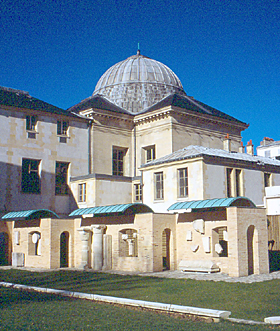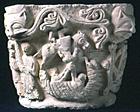- Home
- Archaeology, territory and citizenship
- Archaeology and citizenship
- Archaeology at the Art and History Museum
Art and History Museum, the archaeological lapidary wall.
© UASD / N. Meyer Rodrigues.
In 1981, the Art and History Museum moved into the buildings of the former Carmelite nunnery, using its exhibitions spaces to display the results of the various archaeological excavations. Since then, the Archaeological Unit has contributed to the museum's scientific and cultural program, by ensuring the maintenance and rotation of some six hundred works on display, and by organizing temporary exhibitions.
Musée d'Art et d'Histoire, salle d'archéologie médiévale : chapiteau roman historié, vers 1120.
© UASD / E. Jacquot.
The two archaeology galleries
As visitors enters the first gallery, located in the former nunnery's refectory, they encounter vestiges of the Merovingian necropolis and a collection of Romanesque column capitals that were found in the immediate vicinity of the basilica. A large portion of the gallery is given over to the various facets of everyday life in the Middle Ages, including trade, housing, food and food preparation, music and games, clothing, and crafts. Materials that are rarely found during archaeological excavations are on display, such as wood, leather and textiles.
The second gallery presents medieval ceramics, seen from the perspective of their manufacture, decorative techniques, use, and how the principal pottery shapes changed from the twelfth to the fifteenth century.
The archaeological lapidary wall
In 2000, a wall designed by sculptor Luigi Da Gioz was inaugurated in one of the Carmelite gardens. It features twenty-three sculptural and architectural elements chosen by the Archaeological Unit to illustrate four stone-related themes: materials and origins, sculpting tools and techniques, construction and decoration, and funerary art.
The wall was created for educational reasons, in order to allow visitors to see and touch pieces that are often inaccessible, because they are out of reach or too fragile. The elements presented were chosen to meet these criteria and to supplement an exhibition in the museum's interior. They are complementary to the stone pieces on display inside, which, for preservation reasons, visitors cannot touch.


